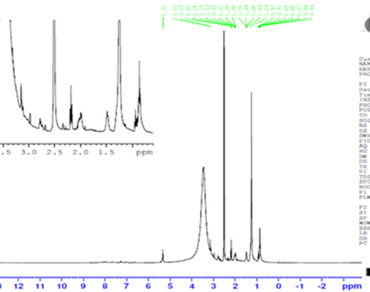A new alternative to chemical fertilizers for arid soils, the cuticle of locust insects
Research Articles | Published: 16 August, 2022
First Page: 779
Last Page: 786
Views: 3525
Keywords: Medicinal plants, Cuticle, Biofertilizers, Soil
Abstract
Among the environmental problems that threaten food security in arid areas is the deterioration of agricultural soils, which has led to the loss of vegetation cover, especially medicinal plants. The objective of this study is to provide solutions for the rehabilitation of arid soils through the use of biofertilizers based on the cuticle of locusts. The chemical analyses of the cuticles were carried out by “X-ray diffractometer”, “nuclear magnetic resonance” and “X-ray fluorescence spectrometry”. The study of the microscopic structure was carried out with an electron microscope.The comparative chemical study of cuticle and arid soil by XRD, NMR and XRF, shows a wealth of 12 chemical elements essential for the development of plants and for the fertilization of agricultural soil. Application of these results to two crops, wheat and corn, shows a 50% increase in biomass and 40% additional yield of wheat cultivation caused to the availability of mineral elements from the biofertilizer cuticle. Regarding maize cultivation, an increase in biomass of 40 and 55% of additional yield was recorded. Microbial activity increased by + 90% compared to soils fertilized with synthetic mineral fertilizer.

References
Abdelghani B (2020) Valorization of raw materials based on fly ash of eggshells and Algerian sand dune (Southern West of Algeria) for synthesis of environmentally cementitious materials: synthesis and characterization. Geotech Geol Eng. https://doi.org/10.1007/s10706-020-01598-7
Abdennour MA, Douaoui A (2021) Geochemical characterization of the salinity of irrigated soils in arid regions (Biskra, SE Algeria). Acta Geochim 40:234–250. https://doi.org/10.1007/s11631-020-00426-2
Austin AT, Yahdjian L (2004) Water pulses and biogeochemical cycles in arid and semiarid ecosystems. Oecologia 141:221
Brahimi D (2019) First data onorthoptera fauna diversity in the arid region of naâma (south west of algeria). Revue Agrobiologia 9(1):1292–1301. ISSN (Print): 2170–1652 .e-ISSN (Online): 2507–7627. www.agrobiologia.net
Brahimi D (2020) First data of statistic and ecological behavior of Orthoptera insects in arid region (Southern West of Algeria). Data in Brief 31:105857. https://doi.org/10.1016/j.dib.2020.105857
Brahimi D (2021) Nouvelles données sur les insectes d’intérêt écologique dans les zones humides, cas des régions arides d’Algérie. Bulletin de la Société Zoologique de France 146(4): 139 à 147. ISSN : 0037–962X. http://societe-zoologique.fr
Christopher J (2015) The chemical fertility of soils: soil nutrients and plant nutrition. Future Directions International Pty Ltd
Chuan CN (2017) Impacts of chemical fertilizer reduction and organic amendments supplementation on soil nutrient, enzyme activity and heavy metal content. J Integr Agric 16(8):1819–1831. https://doi.org/10.1016/S2095-3119(16)61476-4
Constanza BM, Demetrio L (2021) Evidence for soil pesticide contamination of an agroecological farm from a neighboring chemical-based production system. Agric, Ecosyst Environ 313(15):107341. https://doi.org/10.1016/j.agee.2021.107341
Deng H (2015) Parent materials have stronger effects than land use types on microbial biomass, activity and diversity in red soil in subtropical China. Pedobiologia 58:73–79
Doumandji SE (1992) Bio-écologie des orthoptères de trois types de stations dans la région de Dellys (Algérie). Ghent University, Medical FacultyLandbouw
Dregne HE (1983) Soil and Soil Formation in Arid Regions. In: Webb RH, Wilshire HG (eds) Environmental Effects of Off-Road Vehicles. Springer Series on Environmental Management, Springer, New York NY. https://doi.org/10.1007/978-1-4612-5454-6_2
Ewing SA (2006) threshold in soil formation at Earth’s arid–hyperarid transition. Geochim Cosmochim Acta 70:5293–5322
Huanyu, (2020) Hyperspectral remote sensing applications in soil: a review. Hyperspectral Remote Sens Earth Obs. https://doi.org/10.1016/B978-0-08-102894-0.00011-5
Indu S (2021) Himalayan medicinal plants advances in botany. Prod Res. https://doi.org/10.1016/B978-0-12-823151-7.00007-6
Linzhu, (2021) Associative effectiveness of bio-organic fertilizer and soil conditioners derived from the fermentation of food waste applied to greenhouse saline soil in Shan Dong Province. China Appl Soil Ecol 167:104006. https://doi.org/10.1016/j.apsoil.2021.104006
Fernández-Alonso MJ, Rodríguez A, García-Velázquez L, Dos Santos E, de Almeida L, Lafuente A, Wang JT, Singh B, Fangueiro D, Durán J (2021) Integrative effects of increasing aridity and biotic cover on soil attributes and functioning in coastal dune ecosystems. Geoderma 390:114952. https://doi.org/10.1016/j.geoderma.2021.114952
Mcgrath JMJ, Spargo CJ (2014) Encyclopedia of agriculture and food systems. Soil Fertil Plant Nutr. https://doi.org/10.1016/B978-0-444-52512-3.00249-7
Meslier V, Diruggiero J (2019) Endolithic microbial communities as model systems for ecology and astrobiology. In: Model ecosystems in extreme environments. Astrobiology exploring life on earth and beyond. Academic Press, pp 145–168. https://doi.org/10.1016/B978-0-12-812742-1.00007-6
Ons Talbi Z (2018) Combined effects of salinity and phosphorus availability on growth, gas exchange, and nutrient status of Catapodium rigidum. Arid Land Res Manag. https://doi.org/10.1080/15324982.2018.1427640
Pedro A, Sanchez ROGERRB (1997) Land use transformation in Africa: three determinants for balancing food security with natural resource utilization. Dev Crop Sci 25(1997):19–27. https://doi.org/10.1016/S0378-519X(97)80004-9
Peng LI (2021) Different regulation of soil structure and resource chemistry under animal- and plant-derived organic fertilizers changed soil bacterial communities. Appl Soil Ecol 165:104020. https://doi.org/10.1016/j.apsoil.2021.104020
Skujins J (1991) Genesis and classification of arid region soils. In: semiarid lands and deserts. CRC Press, USA, Soil Resource and Reclamation
Steven B (2013) Dryland soil microbial communities display spatial biogeographic patterns associated with soil depth and soil parentmaterial. FEMS Microbiol Ecol 86:101–113
Taibi A (2018) Food larders of the Southern Grey Shrike Lanius meridionalis algeriensis (Laniidae, Passeriformes) in Algeria. North-Western J Zool 14(2):273–275
Vimal C (2020) Fly ash application in reclamation of degraded land: opportunities and challenges. Phytomanagement Fly Ash. https://doi.org/10.1016/B978-0-12-818544-5.00006-7
Author Information
Laboratory “Sustainable Management of Natural Resources in Arid and Semi-Arid Zones”, Department of Sciences of Nature and Life, Faculty of Sciences and Technology, University of Salhi Ahmed, Team 3: Valorization and Conservation of the Biodiversity in Arid and Semi-Arid Zones, Naâma, Algeria